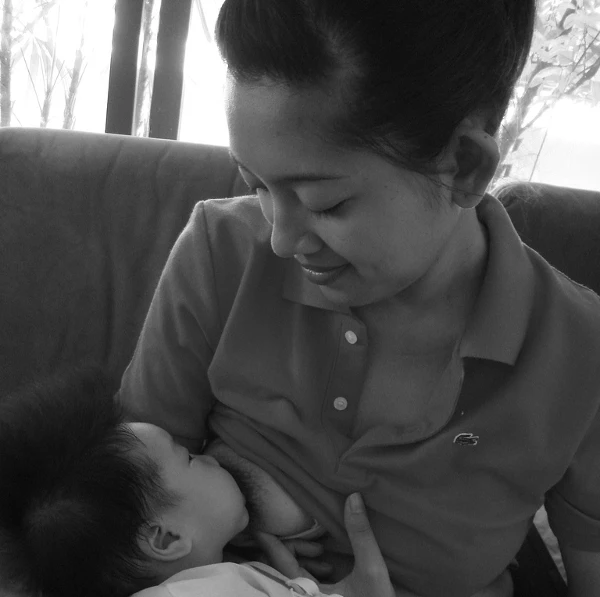The most common problem by far that I have encountered with children and behavioral sleep disorders is that most children who experience problems falling asleep have never learned to fall asleep without a breast or bottle in their mouths. This problem of needing this sleep crutch compounds as they get older and no longer physically need a bottle or breast before going to sleep. As they become toddlers, they are not equipped with the necessary tools and habits to put themselves to sleep. The good news is that it’s never too late to address the problem of baby feeding at night and remedy it. Learn how to end night feedings.
All of these general suggestions are for healthy children over the age of six months who have recently been to a doctor that has eliminated any health reasons for needing to eat in the middle of the night. Many parents may notice a 6-month sleep regression around this time, where previously good sleepers begin waking more frequently due to separation anxiety or changes in their sleep cycles. This is a natural phase and an ideal time to help your baby build independent sleep skills while maintaining consistent routines
Address Your Child’s Hunger Clock
Let’s begin by addressing your child’s hunger clock, making sure she is taking in most of her calories during the day, not waiting to feast at night. Keep a log of her daily diet and check with your doctor if you are unsure of what her intake should be. Make sure your child is not overtired when putting her to bed for either a nap or at bedtime. Proper rest will make accepting changes much easier for her and you. And, as with breaking any sleep crutch, the key to success is consistency.
Reduce the Number of Night Feeds
If you or your pediatrician think your baby still needs to eat at night, or if you want to cut back on your nighttime feedings but aren’t ready to eliminate them all together, restrict feeding to just once per night. Feed her quickly and avoid any other interaction that will encourage her to stay up, play, or cling to you. You can try to dream feed her, which means waking her, or half-waking her, for a final feeding before your own bedtime, probably around 11:00 p.m. Or you can wait until she wakes up, as long as it’s at least FOUR hours after her last feeding, which usually means around 11 p.m. or 12:00 midnight, and then not again until she wakes up in the morning (6:00 a.m. at the earliest). But be consistent! Choose an approach and stick to it. Only feed her once at night and not again until after 6:00 a.m. If she wakes up at other times wanting food, find other ways to calm her. Sit by her crib and offer physical and verbal reassurance until she is asleep. Pick her up to calm her if need be, but not until she falls asleep. Regressions, such as the 6-month sleep regression and 7-month sleep regression, can lead to temporary increases in nighttime awakenings, even in babies who had been sleeping through the night. It’s important to stay consistent with your chosen feeding approach during these phases to avoid reinforcing unwanted habits
How to End Night Feedings
With children from six to twelve months, I usually suggest a gentle and gradual elimination of nighttime feedings. Overnight, try cutting down on nursing time. If she usually feeds for twenty minutes during the night, give her fifteen. Keep cutting back every few days until she’s ready to give it up. Make sure you unlatch her when she finishes eating heartily; don’t let her gently suckle and doze. Get her back to bed while she’s drowsy or awake. Same with the bottle -let her eat, but don’t let her play with it. With a nighttime bottle, you can also try switching to a smaller bottle, put less formula in the bottle, or gradually dilute the formula so that when it gets very watery, she might decide it’s not worth getting up for. When the nursing is cut back to five minutes, or the bottle to three ounces, it’s time to stop – anything smaller is just a tease.
Use a Dream Feed
If you can’t bear stopping cold, then try a dream feed for a few nights, but no more than a week. Dream feeding is when you wake her, or half wake her, sometime between 10:00 and 11:00 p.m. for at least one feeding to tide her over. When you are ready to wean her from the dream feeding, go to her when she wakes and offer physical and verbal reassurance until she is asleep. It usually doesn’t take more than a few days at this age to wean a child overnight from the breast or the bottle. If you eliminate the nighttime noshing, she’ll wake up in the morning much hungrier, and eat more throughout the day. And if she eats more during the day, she won’t need to eat at night, eliminating a vicious cycle and breaking the sleep crutch.
Introduce a Cup
Try to introduce a cup before her first birthday. As babies get older, they become emotionally attached to the bottle or breast. It basically becomes a “lovie” and can contribute to the ingrained habit of waking up at night in search of it. Nurse or bottle feed at set times, and use the cup at set times. Most moms and babies like nursing or bottle feeding during the morning and night, and use the cup during the day, especially with solids at mealtime. Don’t let her fall asleep on the breast or bottle, though! And encourage the attachment to a lovie.
With infants, a gradual elimination of nighttime feedings is best, but after her first birthday, it’s usually best just to stop cold. When she wakes up at night wanting to nurse or take a bottle, sit by her side and find other ways to calm her. Pat her mattress a bit and whisper “sh-sh-sh,” and tell her it’s nighttime. Don’t cave in and feed her or the inconsistency, the intermittent reinforcement, is going to make the change more prolonged and difficult for her.
Toddlers need to begin eliminating the nighttime noshing by changing from nursing or bottle feeding before bed to drinking from a cup. The goal is to have your child drink a cup of water instead of milk before bed (or nothing at all). Milk encourages the child to want it again every time they stir or wake during the night. A cup of water (a sippy cup or sports bottle) by the bedside will encourage your child to wean herself from milk. Not to mention, your child’s dentist will approve! But be firm in allowing only one cup that has to last all night. You will not keep coming back to give her more.
Consistency is Key to Eliminating Night Feedings
As with breaking any sleep crutch, consistency is the key to success. Once you begin a new habit, do not go back! It will confuse the child and take twice as long to break this sometimes emotional need to nosh at nighttime. Focus on bedtime – drowsy but awake. If your child is put into her crib or bed asleep, then these nighttime techniques will NOT work. Gently encourage and offer reassurance. Present lovies or a new stuffed animal friend to help with the change. Often, the stuffed animals can “hold” the new big girl sippy cup on a nightstand during the night in case your child needs it. Your loving words, gentle touch, and soft voice will go a long way in making this a quick change for everyone!
Good luck!




